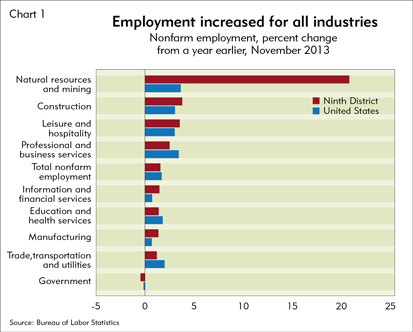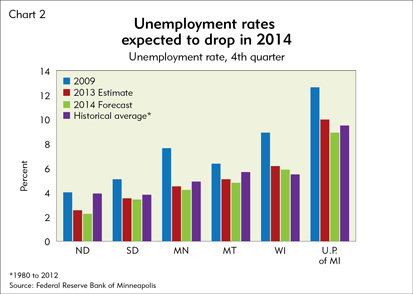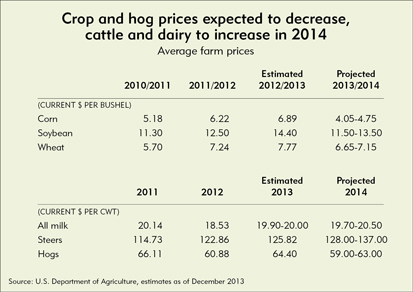The sky will continue to clear in the Ninth District in 2014, as the economy is expected to grow moderately. The sun will shine brightest on North Dakota, where a boom continues in oil and gas drilling and production.
According to the Minneapolis Fed’s most recent business outlook poll, respondents’ outlooks for their communities are the most optimistic since before the Great Recession. Moreover, the Minneapolis Fed’s economic forecast models indicate moderate employment and income growth in 2014.
Employment posted broad gains
November nonfarm employment increased in all sectors except for a slight decrease in government employment compared with a year ago (see Chart 1). District employment growth was essentially the same as the nation’s (1.6 percent and 1.7 percent, respectively).
The strongest gains were in natural resources and mining (21 percent). This sector includes brisk employment growth in oil and gas production in western North Dakota and eastern Montana. In September, this region produced almost 28 million barrels of oil, up 29 percent from a year earlier. The number of active drilling rigs in the area is down somewhat from a year earlier, but drilling activity remains at high levels. In addition to employment growth from oil and gas exploration in North Dakota and Montana, natural resources and mining employment also posted increases in Minnesota and Wisconsin. Nevertheless, natural resources and mining is a relatively small sector in the district, representing less than 1 percent of total employment.
Outside of natural resources, the fastest growth was in construction (3.8 percent), leisure and hospitality (3.5 percent) and professional business services (2.5 percent). Government employment decreased slightly (-0.4 percent), which continues a trend of softer employment levels in the sector. Since November 2010, government has shed 14,600 jobs in district states—cuts that were initially delayed during the recession by federal fiscal stimulus and compounded by federal sequestration that started last March. Congress recently passed a two-year federal budget that curtails some of the sequestration spending cuts.
Results of the Minneapolis Fed’s forecasting models indicate that employment will grow modestly in 2014 at rates slightly below historical averages (1981 to 2012), except in North Dakota, where employment is expected to grow 4.5 percent. More respondents to both the business outlook poll and the manufacturing survey expect increases in employment at their companies than expect decreases.
Unemployment rates continue to drop
Unemployment rates have dropped across all district states since the end of the recession (see Chart 2). In November, the unemployment rate in North Dakota decreased to 2.6 percent, the lowest in the nation. Unemployment rates are forecast to continue their downward trend during 2014 and will finish the year below each respective state’s historical averages, except for Wisconsin, which will remain above its historical average.
With unemployment rates coming down and employment picking up, business leaders are reporting more difficulty finding qualified workers than in the past few years. During the recession and shortly thereafter, business owners frequently reported receiving plenty of qualified applicants in response to job postings. According to the business outlook poll, 57 percent of respondents said that securing workers was a challenge or a serious challenge, up from 39 percent of respondents in last year’s poll and only 14 percent in the 2010 poll.
However, businesses are not generally raising wages much in order to attract workers, nor are businesses broadly expecting to offer substantial wage increases in 2014. Some exceptions are noted, such as relatively high wage offerings in the oil and gas region of North Dakota and Montana, but even the rapid increase in wages there has eased somewhat.
In manufacturing, wages in district states increased 2.4 percent during the three-month period ended in November compared with the same period a year ago. The strongest manufacturing wage gains were reported for North Dakota, which increased 3.4 percent, while manufacturing wages decreased 1.9 percent in Montana. According to the business outlook poll, 93 percent of respondents expect wages and salaries in their communities to increase 3 percent or less in 2014, the same percentage as last year.
While wage increases have been moderate, so have overall price increases. From a national perspective, in November the personal consumption expenditure price index was up 0.9 percent from a year earlier. In the district, a somewhat larger share of respondents to the business outlook poll and survey of manufacturers expect to increase prices for their own products and services in 2014 compared with the previous year.
Home sales and construction continue to recover
Residential real estate markets continue to recover with increases in home sales, prices and construction during 2013. In Minnesota, the number of closed sales increased 5 percent year-to-date through November compared with a year earlier. However, the pace of sales slowed during the last couple of months.Home prices have posted gains in many areas of the district. During third quarter 2013, prices for sales of existing homes increased 15 percent in Minneapolis, 12 percent in Bismarck, N.D., 5 percent in Fargo, N.D., and 4 percent in Sioux Falls, S.D.
Home building has also taken off during the past two years, with housing units authorized increasing 50 percent in 2012 and 19 percent in district states through November 2013 compared with the same period a year earlier. Authorization levels are the highest since the start of the recession, but are still far behind annual levels recorded from the early 1990s to 2007.
The manufacturing sector also expanded during 2013, with gains recorded throughout the year in Minnesota and the Dakotas, according to a survey of purchasing managers by Creighton University (Omaha, Neb.). However, manufacturing was slowed somewhat by soft growth in manufactured exports; through October 2013, levels were about the same as a year earlier. Exports to Europe and China grew modestly during the first 10 months of 2013 after decreasing the previous year; however, exports to the district’s largest trading partner, Canada, decreased slightly. One likely factor is the exchange rate; during 2013, the U.S. dollar strengthened about 8 percent against the Canadian dollar, making district exports relatively more expensive in Canada.
Consumer spending grows moderately
Increased employment, gains in home prices and growth in equity prices have generally helped improve household balance sheets. National consumer confidence measures have continued to recover from the recession. The increase in confidence coincided with improved economic news on consumer and business spending.
Prior to the holiday sales season, respondents to a survey of holiday shoppers in the Minneapolis-St. Paul area by the University of St. Thomas indicated that spending per household would increase by about 8 percent over 2012. Retailers in the district have generally reported modest gains in holiday traffic and sales. In 2014, personal income in all district states is expected to grow faster than in 2013, according to the Minneapolis Fed’s forecasting models, a positive sign for consumer spending. However, respondents to the business outlook poll and the survey of manufacturers expect only slight gains in consumer spending for their communities and states in 2014.
Tough weather, falling prices weigh on farmers
Going into 2013, farmers were hoping for a happy medium. After pervasive flooding around the district in 2011 and severe drought in 2012, a normal weather year would have been welcomed. Instead, farmers got both extremes—heavy rains in the spring delayed and even canceled planting for some producers, then the water abruptly shut off in midsummer, leading to drought conditions in many areas by harvest time. But by the end of the growing season, the toll was mixed across the region. Total district corn production increased 9 percent. In contrast, production fell in the district for wheat (down 13 percent), soybeans (6 percent), sugar beets (10 percent) and dry beans (36 percent).Crop prices, however, unmistakably took a turn for the worse for farmers, and forecasts indicate that this is expected to continue in 2014. Coming on top of several years of strong prices, the 2012 drought pushed crop prices higher in late 2012 and early 2013 (see table). But over 2013, that effect faded, and once it was clear that states outside the district would get better weather and see stronger production this year, crop prices fell. Though corn production rose across the district, higher production in South Dakota and Wisconsin was largely due to poor, drought-ravaged production in 2012.
The story has been the reverse for animal product producers, who were hampered in 2012 by higher crop input prices and a slight decline in meat and dairy prices. While the cost of feed fell for them in 2013, they saw their output prices for cattle, hogs and dairy all increase, pushing up profit margins.
According to the Minneapolis Fed’s third-quarter (October 2013) agricultural credit conditions survey, 2013 was a moderate year for agricultural income, with over half of respondents reporting steady income, while more reported decreased incomes (28 percent) than increased (16 percent). Capital investment behaved similarly, while farm household spending mostly increased or was flat, with only 6 percent of lenders reporting decreases. Agricultural lenders are somewhat pessimistic for farm earnings in the final quarter of 2013, with 48 percent expecting income to fall and only 16 percent expecting it to rise.
The outlook for 2014 is for these trends to continue. According to U.S. Department of Agriculture forecasts, prices for corn, soybeans, wheat and hogs are expected to decrease, while milk and cattle prices should continue to climb. However, if history has taught us anything, it’s that agriculture is full of surprises.
Joe Mahon is a Minneapolis Fed regional outreach director. Joe’s primary responsibilities involve tracking several sectors of the Ninth District economy, including agriculture, manufacturing, energy, and mining.









